By Lambert Strether of Corrente.
This may run a little thin for a biosphere perambulation post, since I have a household event to contend with. So here’s an hour-long YouTube of aspens in the wind for you to listen to, as compensation:
(One of my main use cases for my iPad is listening to soothing white noise, which the quaking aspen (populus tremuloides) certainly provides; the slightest breeze causes its leaves to flutter.
Since there seems to be no precise definition of a tree[1], I will happily skip over taxonomy and go straight to the aspen’s range:
The quaking aspen (Populus tremuloides) is the most widely distributed tree in North America (Map 1). The species ranges from Alaska to Newfoundland and from Virginia to northern Mexico. It is found at sea level in the northern end of its range and at 1,500 feet elevation in the southern end. In Oregon, the brilliant spring green and magnificent golden fall foliage of quaking aspens can be seen in the Cascades, the East Cascades Slopes and Foothills, and the Blue Mountains ecoregions. Only a few aspen stands occur in the Coast Range and the Klamath Mountains. More can be found in the high ranges of the Oregon desert such as Steens Mountain, Hart Mountain, and others.
Here is a handy map:
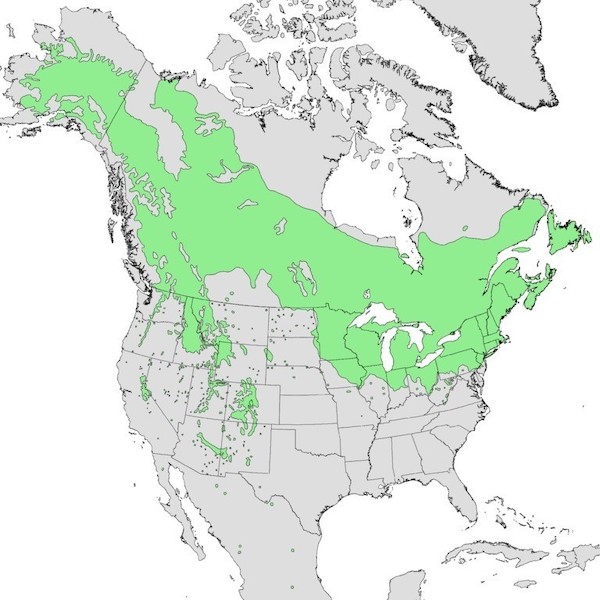
Purple prose like “brilliant spring green and magnificent golden fall foliage” is not rare in the literature on aspens, not even from case-hardened Federal bureaucrats (Forest Service: “glow in a patchwork quilt of these different hues”). Perhaps that’s because aspen groves are ludicrously beautiful:
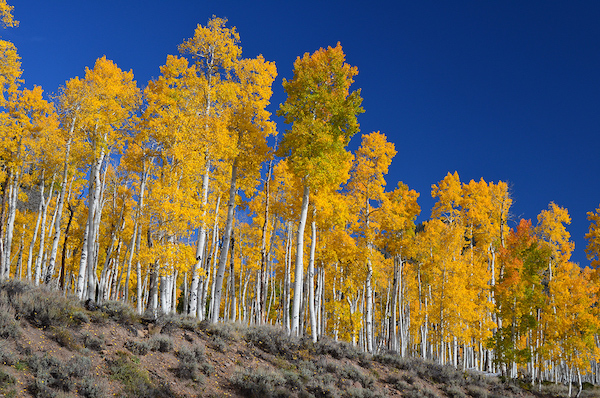
(This is an photograph of the Pando clone, of which more below.) Here is a drawing of a single fallen yellow aspen leaf (by Sarah Drummond, winner of the American Museum of Natural History Young Naturalist Award for an essay on the aspen):
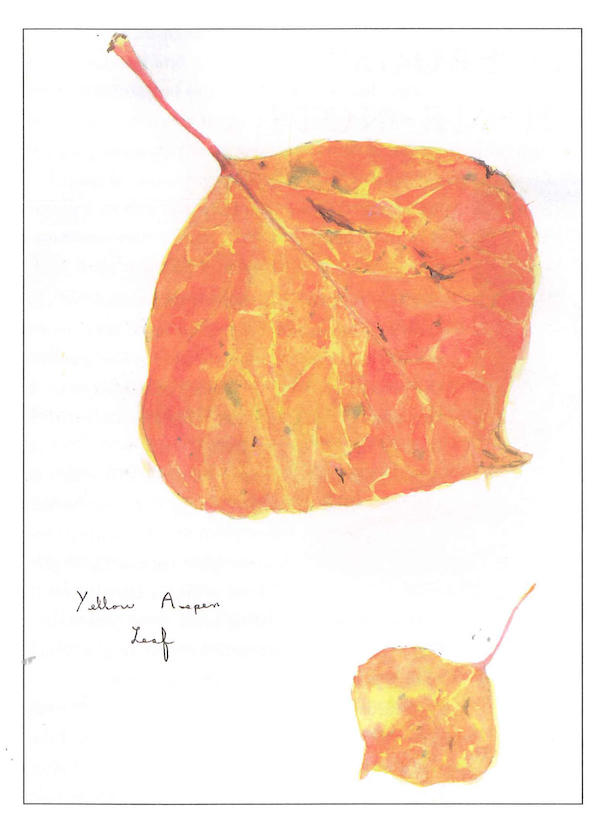
But why do aspen leaves tremble? Nature answers, at length:
[D]ue to the physical structure of the leaf stem (petiole) which traces a flat, oblong, elliptical pattern when viewed in cross section (i.e., perpendicular to the stem itself) so it has strength in one dimension (the long part of the ellipsis) and minimal strength in the second dimension (the narrow part of the ellipsis), so even a gentle wind causes shaking, quaking and trembling. We understand this phenomenon very well mechanically, yet a deeper question can be posed: Why does the petiole develop this way? Plant physiologists have pointed out several consequences of the trembling leaf behavior to include minimizing the risk of too much sunlight on the photosynthetic apparatus (photoinhibition), reducing the risk of overheating in intense, high elevation sunlight and improving photosynthetic rates by keeping a fresh supply of carbon dioxide near the leaf surface where the plant takes up that compound. Taking a different approach, one of our students did a small scale independent study several years ago where she identified matched pairs of aspen leaves and stabilized one with tubing to reduce its ability to tremble, then measured the amount of leaf damage due to insects near the end of the summer, comparing the leaves which could tremble with ones that could not. She found the insect damage to the ‘fixed’ leaves was, on average, about 27% higher in the stabilized members of the pairs.
So the trembling behavior is not so much like whispering, as it is like brushing away insects.[1]
Now we turn to aspen’s most salient feature: how it reproduces. From Nature:
Aspen form individual patches comprised of numerous stems, termed ramets, each with its own trunk, branches, leaves and a shared root system (Figure 2). All of these structures arose from a single aspen seed, often in the very distant past; while these patches remain connected via root systems, they comprise a single clone. If the root system between patches is severed, the patches form physiologically separate entitites but are generally still considered part of the same clone given that they are composed of genetically identical patches and parts, having been produced vegetatively. The boundaries of different clones stand out most clearly in the early spring when flowering and leafing-out occur (in that order). Aspen occur as males and females separately (dioecious), unlike the majority of tree species, which support both male and female reproductive parts on each individual (monoecious or hermaphroditic).
A diagram (we’re skipping the catkins):
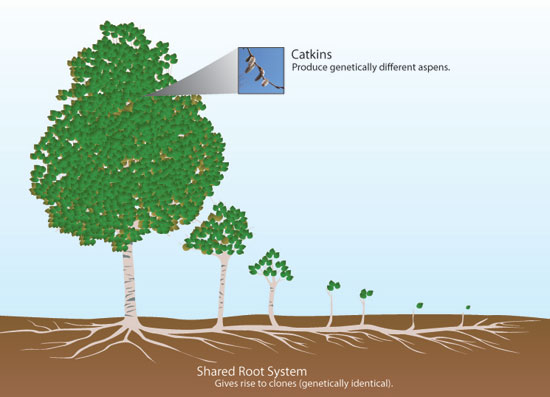
In Utah, there is an aspen clone called Pando (Latin: “I spread”[3]), which weighs 13,000,000 pounds and might be the oldest living thing on earth:
Until recently, rough estimates had [Pando] at something like 80,000 years old; this has been revised down significantly in light of the fact that the area of Utah in which it lives was covered by an ice sheet 20,000 years ago, a problem even the most badass tree would have trouble surviving. Pando’s now clocking in at a mere 15,000 or so.
Unlike the bristlecones, which can be dated accurately through tree rings, it’s pretty hard to get a fix on Pando’s exact age. This is because Pando is a tree colony. Quaking aspens have the curious property of being able to reproduce themselves clonally, sending up new seedlings from their roots. These ‘ramets’ function, for all intents and purposes, as baby trees, living and dying just like you’d expect any stand-alone aspen to.
But they’re all the same organism. Pando is a 13 million pound collective of more than 40,000 stems, genetically identical and all grown from the same massive (100+ acres, easily) root system. It cares about individual stems just about as much the average person might fuss about individual hairs on their head.
I had no idea I would discover the world’s oldest (and heaviest?) living being when I wandered into this topic area! That said, aspens in general and Pando in particular are threatened, first by cows[4]:
Our results show that the brief but intense cattle grazing appears to be a major contributor to the decline of the Pando Clone, as well as other aspen groves in the immediate vicinity, in addition to the much lighter continuous herbivory by mule deer. Based on comparisons of the exclosures with the area open to both livestock and mule deer that this high level of use in the unfenced areas effectively eliminates regeneration. A previous study (Rogers and McAvoy 2018) attributed the failure of the Pando Clone to regenerate solely to mule deer, but our results indicate that cattle are also having a major impact on understory vegetation. Our results suggest that livestock herbivory may be having a synergistic interaction with mule deer foraging to suppress aspen sprout growth, and that trampling of soils by livestock may also play a role in depressed aspen recruitment in unfenced portions of the Pando Clone and adjacent aspen stands. Based on our results, we recommend removal of livestock from the Pando Clone area to protect this globally significant organism, and also recommend that livestock be removed from public land pastures elsewhere where aspen groves show signs of depressed regeneration.
The cow problem (“cow-bombing“) is general:
In the American West, the original 9.6 million acres of quaking aspen is down to just 3.9 million acres. The decline of quaking aspen in the American West has been severe and is mostly attributable to the onslaught of domestic livestock. Any amount of grazing by domestic livestock is harmful to aspens, as the bovines trash the understory and nip off all the replacement shoots from the root system.
Fortunately, cow-bombing is fixable:
But saving [Pando] may be as simple as putting up a good fence.
To test their idea, [Paul Rogers of Utah State University and the Western Aspen Alliance] and his colleagues fenced in 7 hectares of the grove. They also tried to stimulate tree growth by burning vegetation, clearing juniper bushes growing among the trees, and cutting mature aspens, all of which can cause new trees to sprout.
After three years, the part of Pando that was inside the fence contained more than eight times as many stems per hectare as an unfenced area. Though the burning, clearing and cutting enhanced growth, simply excluding browsing animals drove most of the change….
“It was a neat surprise that we can get pretty good results with fencing alone,” Rogers says.
What works for Pando might not work elsewhere, however. Installing barriers around large regions of the American west or whole mountain ranges would be impractical, Rogers notes.
I dunno. Nuking 9.6 million – 3.9 million = 5.7 million acres of a keystone species (more below) is practical? Really?
Aspens are further threatened by fire suppression. From the Forest Service:
Fire suppression has allowed conifers to spread into aspen groves where they shade the aspen. Since it is intolerant, the aspen begins to decline. Fire suppression also means that the above ground aspen are not killed, so the clone does not sprout. Aspen trees are short lived and need the sprouting response to keep the clone healthy. As the above ground aspen decline in health so does the vigor of the clone and this creates a cascade effect in the tree’s decline. As the clone becomes weaker the sprouts are fewer and grazing animals have more of a negative effect on the tree.
Drummond describes the process that ought to be happening, but isn’t:
Aspen root systems can remain dormant for centuries, awaiting the right conditions for regrowth. Dense conifer stands frequently shade out aspen, but the aspen roots remain healthy and alive underground until their evergreen neighbors are felled by fire or wind or man. Sunlight then awakens the aspen’s roots and triggers the growth of vertical stems, called ramets. Aspen are often one of the first plants to revive and revegetate after a fire.
Drummond has more faith in dormancy than the Forest Service does. And then there is drought, which also affects dormancy:
More recently, however, “sudden aspen decline” (SAD) has been reported. As of 2007, widespread, severe, rapid dieback and mortality had affected about 13 percent of the aspen in Colorado. SAD is different from what is traditionally referred to as aspen decline. It is occurring on a landscape scale, versus the stand-level changes that are typically noted with aspen forest related to disturbance and succession. The mortality is rapidly occurring over a few years, versus the typical changes occurring over decades. In addition, pathogens and insects associated with SAD are different from those usually associated with aspen mortality in Colorado. Evidence indicates that warm drought conditions earlier in the decade played a primary inciting role, that certain stand and site factors predisposed aspen to damage, and that the pathogens and insects are killing stressed trees.
An accelerated dieback of aspen was also observed across northern Arizona following two defoliation events and several years of drought. A secondary disease and/or insect was found to be associated with the dying trees as well, including canker fungi, wood borers, and clear wing moths. Aspen regeneration by suckering was observed after the dieback, but little of it remained after heavy ungulate browsing. The extensive dieback and ungulate browsing of the aspen suckers is expected to result in forest type conversions, from aspen to conifer, in many of these sites across the state.
Aspen reproduce primarily by sprouting from root systems, rather than spreading seeds. Each “clone” can live hundreds or even thousands of years. A stem may die, but beneath the soil, the root sends out fresh shoots, and the cycle begins again. The aspen stands with dying trees do not seem to produce shoots to replace old trees as they normally would, which may be related to years of drought that inflicted deep damage.
Yikes.
Finally, let’s consider the aspen’s role as a keystone species (i.e., one that it would be really good not to kill off by cow-bombing, fire suppression, and drought, because so many other creatures depend on it. Many, many conceptualizations of “keystone species” focus primarily on predator prey relations, with predators as the keystone. For example, from Nature:
Keystone species have effects on communities that far exceed their abundance. That is to say, the importance of keystone species would not be predicted based upon their occurrence in an ecosystem. Dominant and keystone species influence the presence and abundance of other organisms through their feeding relationships. Feeding relationships — eating or being eaten — are called trophic interactions.
Nature provides a diagram:
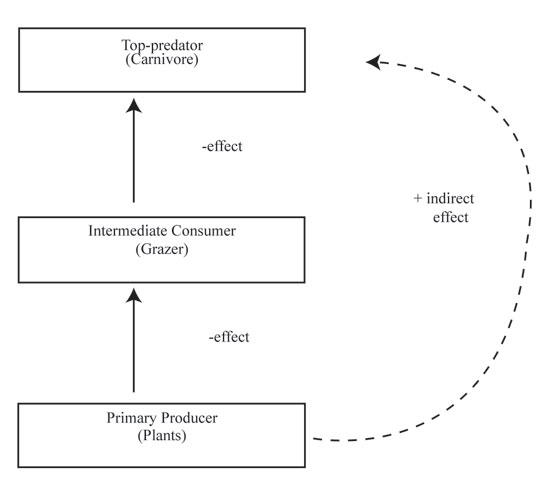
Elsewhere, I have urged that diagrams like this:
[remind] me of academic politics, although some departments (***cough*** economics ***cough***) are no doubt far worse than others. Speculating freely, one might wonder whether these academics find predator-prey relations so powerful and illuminating as an analytical tool because they mirror the relationships that matter most to them in their professional lives. Department chairs, red in tooth and claw, as it were.
Silicon Valley, too, whose use of the word “ecosystem” is transparently predatory. It now strikes me that Nature’s diagram is nothing more than an org chart. And if you know anything about institutions, you know that the org chart does not necessarily relate in any way to the real functioning of the institution it purports to represent. I mean, there’s already one dotted-line relation in the Nature diagram; and where there’s one, there are more.
I prefer a concept of keystone species that permits a broader variety of relationships than predator-prey. After all, trees can hardly be predators, not even Ents! The Natural Resources Defense Council provides such an alternative:
Keystone species maintain the local biodiversity of an ecosystem, influencing the abundance and type of other species in a habitat. They are nearly always a critical component of the local food web. One of the defining characteristics of a keystone species is that it fills a critical ecological role that no other species can. Without its keystone species, an entire ecosystem would radically change—or cease to exist altogether. It’s important to note that a species’ role can change from one ecosystem to the next, and a species that is considered a keystone in one environment may not be considered the same in another.
NRDC provides five types of keystone species: “Predator, Prey, Ecosystem engineer, Mutualist, and Plants.” (We considered the role of the beaver as ecosystem engineer here and here). They write:
[T]he boreal forest forms a ring around the majority of the world’s northern latitudes just below the Arctic Circle. In the Canadian boreal, the snowshoe hare is an example of a keystone prey species, serving as food for the threatened Canada lynx (which relies on snowshoe hares for more than 75 percent of its winter diet), and other predators. In the boreal, keystone species also include trees like aspen and willow (these provide critical habitat for myriad organisms like lichens, fungi, insects, and birds) and plants like wild red raspberries, which are a critical food resource for animals from bees to bears.
Drummond writes:
Without the aspen, the biodiversity of the Montane Life Zone would be significantly decreased. Most species in a given ecosystem owe their existence to the myriad connections to other species, none overly abundant but together creating a functional whole, an interdependent community able to meet the needs of all its inhabitants. There are also organisms that play versatile roles, supporting and strengthening all of the others and providing the building blocks of a habitat. Aspen is one such keystone species. The threads of life are all interwoven; in this mountain forest, aspen makes possible many of the connections
It seems, then, that there are many more types of keystone species than the five proposed by NRDC, and that a broader focus on teasing out these types (“versatile roles”) would be interesting and useful. I think that the concept of “ecosystem services” — which I really have to gird myself to investigate — is trying to occupy that space, but my spidey sense tingles, because to me a synonym for “service” is “can be given a price and commoditized.” What price Pando?
And that YouTube should be just about done by now!
NOTES
[1] How to identify quaking aspens:
An easy place to start with identification is the bark. Young trees often have a creamy white (or even light greenish) bark that is fairly smooth. Because of this, it is often confused with paper birch. Unlike paper birch, however, aspen bark does not peel away from the trunk. As aspens age, their bark becomes furrowed and dark gray or even black, especially toward the base. Quaking aspen leaves tend to be almost circular. Again, the flattened petiole is a dead giveaway. If it is difficult to roll the petiole between your thumb and finger, it is probably an aspen leaf.
[2] Fortunately, there is an actual account on Twitter run by an aspen tree, @iamthepandotree, which provides other true facts. About “eyes”:
My “eyes” are actually branch scars, the places where branches fall off as my stems grow. According to legend, we aspen trees use our eyes to watch over children. #pando#pandoforest#aspenclone #fishlakenationalforest#worldslargesttree#aspeneyes#treeeyes#theyrewatching pic.twitter.com/34KP60Dwvl
— iamthepandotree (@iamthepandotree) April 2, 2021
And about bark:
We aspens have a nifty trick for making energy in the winter-time. We have chlorophyll in our bark which lets us photosynthesize year-round, even without our leaves.#pando#aspenclone #fishlake#Treelife#worldslargesttree#aspen#photosynthesis#aspenbark@AmForestFndn pic.twitter.com/Q0WiWcfsJg
— iamthepandotree (@iamthepandotree) April 7, 2021
Aspen bark has also been used for medicinal purposes:
The bark of quaking aspen was used by pioneers and American Indians as a fever remedy, as well as for scurvy. It contains salicin (similar to the active ingredient in aspirin). A substance similar to turpentine was extracted and used internally as an expectorant and externally as a counterirritant.
[3] From the same source: “Decadent stasis might be an interesting fantasy, but nature is built from Pandos, systems that masquerade as individuals and persist into what might as well be eternity.” Hmm.
[4] Contrast the more polite and less destructive behavior of elk. Once more from Sarah Drummond:
When other vegetation is low or snow-buried, elk use their incisors to scrape off aspen bark. Damage to the tree is seldom very great, since elk tend to browse lightly, taking only a bite here and there throughout a grove. They rarely girdle a tree except in times of severe stress or food shortage.
And from Drummond’s notebook
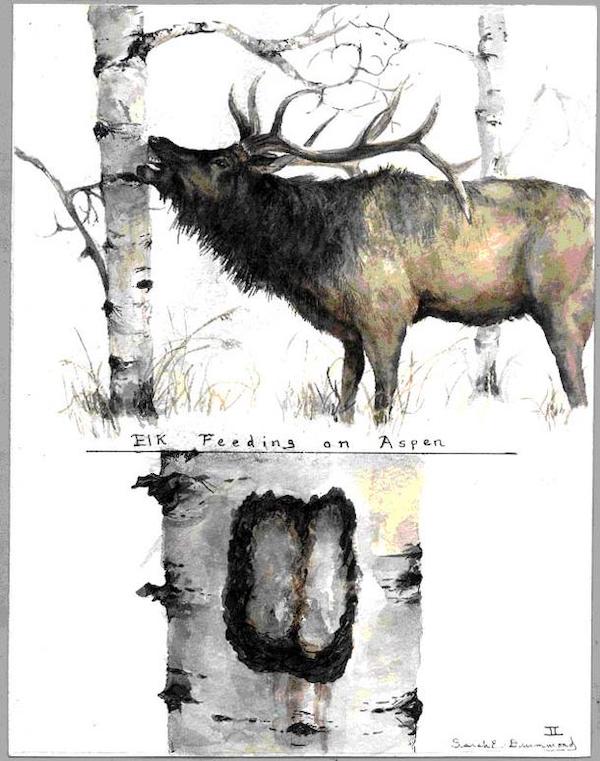


Thanks, this kind of article is why I am here, and donate when I can!
I’m pretty dedicated to my Olympic Peninsula mountain retreat, (no Aspens here, we have Alders instead) …but one of the very few things that might someday cause me to think about moving – or maybe more particularly, buying another small parcel of land – is Quaking Aspens.
Enjoyed them as a kid in Eastern Oregon road trips, and really fell in love with them when camping one summer in Colorado: that and some insanely beautiful red rocks in the creeks that flowed in between the Aspen groves.
What fun this dispatch from the forest!
I think the only place on the western slopes of the Sierra with Quaking Aspens is in Mineral King Valley, which never disappoints in a display of fall colors, but all it takes for the leaves to fall is an early October rain, game so over.
If there isn’t any rain, they leaves fall of their own accord in early November and what was brick red beautiful become skeletal trees that only grow in a relatively small range of around 400 feet from the lowest altitude Aspens to the highest.
The east side of the Sierra is lousy with Quaking Aspens in comparison, they’re all over the place, just saw some growing cheek by jowl next to Canyon Live Oaks, which was pretty damned unusual.
I’ve got about 15 trunks of quaking aspen on my 2 acres of otherwise new-growth (semi-trashy) woods in semi-rural Wisconsin. I thought they were birch because of the bark but it only looks like birch from about 30 feet and up – below that it is dark and furrowed. They might all be one clone – there are about 10 in one stand and 3-5 in another maybe 100 feet away. They are mostly all very large – 10-16 inch diameter trunks and 50-70 feet tall but there is one that is smaller. Now I need to go out and see if there are shoots. Once I clear the buckthorn and mulberry, I’ll work at trying to get them some more full sun. The black locusts grow really fast around here, though their canopy is pretty thin. (They also fall over very easily, so several of the aspens are tilting from having been landed on by falling locust trees.) Otherwise black walnuts and black cherries. Hoping to clear some space and reintroduce oaks.
Neat – I went down a ‘black locust’ rabbit hole. Hadn’t heard of those before…but then looking em up I realized they were the trees planted along a small portion of our neighbors fence line years ago back on the farm in Oregon. Growing up I was intimidated by the thorns, but it turns out they are some pretty cool trees: https://smallfarms.cornell.edu/2018/01/black-locust/
I may just have to get one or two and see if i can get ’em to grow at my place! :)
We get honey locust and black locust in Pa. their flowers smell out of this world, I like the tree in general, though it has a crazy growth pattern a lot more akin to a large shrub.
The black locust grow like weeds here. Very skinny trunks and they twist to try to find the sun, no branching until the very top. They are fun to look at and smell nice but they grow so tall so fast that they are very fragile. I probably have at least 5 40-50 footers that have been blown over and are leaning on or wedged against various other trees.
Cool post. The shaking action being a way to prevent leaf burn makes a lot of sense. These trees are in areas of intense sunlight, it seems to me. I don’t see them where I hunt in north central PA that often, but when I do they aren’t really hanging out with the oaks. They seem to like open ridges.
A great addition to my white noise library. Thanks
I like to observe birds, and I’ve often noticed how good shaking leaves are at camouflaging birds or distractingly pretending to be birds. I bet quaking aspens are songbird friendly by making it harder on songbird hunters.
Thanks so much Lambert! This is the most coincidental post evah! We moved to a new home last fall and I have been in full tilt gardening mode all spring. I want to plant some trees and have been making a list of favs. Have decided to wait ’til this fall to plant … for one – to have a full year of living here and getting to know what we already have, two – because we have a huge gypsy moth problem in our area and I don’t want to buy the little buggers any new trees to munch and three we’ve been getting way more rain in late summer and fall than in spring in Ontario the last few years so it seems to me that tree and shrub planting should wait for all that good fall rain.
Now to get to the point, I was at a garden centre the other day to pick up a few more veggie plants and perennials and just browsed the trees to see what they had. I was blind-sided by a quaking aspen sapling. It was such a lovely little tree, as I stood there admiring it, I made a mental note to do some research as I don’t know anything about them. Two days later, I have yet to do any searching and here is this lovely post!
Cheers!
Sometimes an action or an organ-feature may have two or more functions at the same time. The experiment described above showed the value of aspen leaves trembling in insect damage reduction. But could it be doing one or more of the other things too, at the same time?
How would one design experiments to find out?
Here is a video about human-made animal crossings over and under highways. It is so cheering it could maybe be an antidote.
https://i.imgur.com/Lf4dCD7.gifv
I was so impressed with 11-grader Sarah Drummond (note that her essay was from the 1998-2003 period) – as she was an accomplished observer, writer, illustrator and naturalist at that young age – that I had to learn more about what she is doing now. So here is what appears to be her website:
http://www.sarahdrummondart.com/
Interestingly, the AMNH award is not listed:
http://www.sarahdrummondart.com/About-the-Artist.html
Is this her, or is this just another similarly accomplished Sarah Drummond?
A great post this, just like the one on Kelp. Those Aspen trees really stand out and have often seen them in photos. I wonder if beaver attacked them for building materials for their dams. This post makes me wonder what tree will next feature in a post.
Aspen trees are the preferred tree for beaver dam building in the Mountain West (US). There is a synergy going on: The dams raise the water table in soils adjacent to beaver ponds which encourages the wet soil loving Aspen.
Aspen groves in the Wood River Valley (Idaho) can be seen on the slopes of foothills where the geology has allowed soil water seepage. The lower hills are covered with grasses and sagebrush and then a Aspen grove will be interspersed in the foothill landscape. Over the years these seeps can diminish from drought and the grove will consequently recede. The eastern Sierra Nevada has some brilliant Fall displays of Aspen gold.
Not all Aspen leaves turn yellow/gold. Some turn red/burgundy in locations with the right climate and soil for the tree to produce appropriate anthocyanins (pigments).
Thanks Lambert. Nice to read good news about Pando.
The one practical issue that might come with widespread cow-proof fencing is that it may disrupt movement/migration of native wild animals. The parts of the border with Mexico that are fenced are pretty disruptive to animals that want to cross it. A fence that kept only cows out would be ideal!
Not to confuse American quaking aspen (Populus tremuloides) with Euro/Asian one (Populus tremula), which both are in English sometimes refered to as “quaking aspen”.